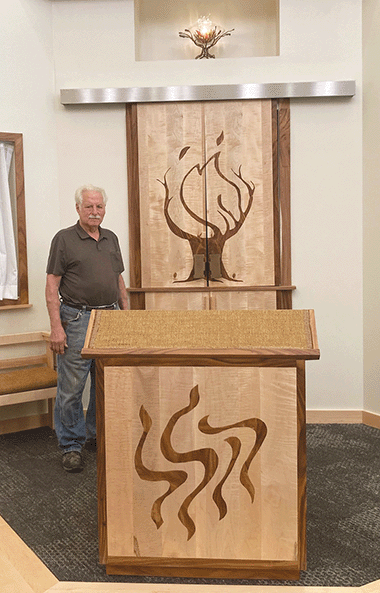By DORIS RUBENSTEIN
Bezalel is mentioned numerous times in the Torah’s Book of Numbers as being the architect of the Tabernacle and the Ark of the Covenant. So revered is he in Jewish tradition that his name is attached to the Bezalel Academy of Art and Design in Jerusalem. His work is recounted in the Torah in minute detail, so much so that a 21st-century artisan would be able to rebuild and redecorate the Mishkan (tabernacle, or dwelling place of God) should the Mashiach (Messiah) come tomorrow.
So, when the rabbi of the Great Synagogue of Trieste, Italy, saw photos of the new aron kodesh (holy ark) made by Allan Schultz in Minnesota Hillel on the University of Minnesota campus, the rabbi pronounced Schultz to be “the new Bezalel.”

Hillel’s building got a major remodeling in 2019 and 2020. The chapel was completely gutted, reorienting the direction of prayer from the south to the traditional east. A grant from Rimon: The Minnesota Jewish Arts Council gave Schultz — and Hillel — nearly free rein to construct the bima (pulpit) furnishings according to his own vision.
The choice of woods — maple, for Minnesota’s forests, and acacia, which was used in the original ark — reminded me of King David’s Temple, which was also mostly wood.
Schultz came to woodworking on a wandering path. Before he turned to the artisanal pursuit, he had a varied career: middle school science teacher, emergency medical technician, 13 years as a furniture craftsman, scientist, engineer and corporate executive.
Upon his retirement from the corporate world, he felt called to return to woodcraft and has dedicated over a decade exclusively to that field. His Jewish heritage is represented in a broad range of religious and ritual items he makes: arks, amudim (lecterns), hanukiot and Kiddush cups.
“My grandfathers, both superb craftspeople, would have been proud of the way I carried on the family tradition,” Schultz said.
Schultz takes his woodworking craft into the realm of art with the three pieces of furniture he designed and built for the chapel: the aron kodesh, the amud and a chair for the rabbi or the shaliach tzibur (prayer leader). For more examples of his work, visit his website, thenaturaledgemn.com.
There’s no guessing about which university this Hillel serves; aside from the wood, many of the trappings are in University of Minnesota colors, maroon and gold. The symbolism goes further when the ark is opened to reveal a set of sifrei Torah (Torah scrolls) dressed in new mantles with the U of M colors. Diane Lovich, Etta Barry, Jane Lifson, Libby Kaplan and Jennifer Kaplan stitched the mantles with contemporary designs.
Minnesota Hillel is lucky to have one of the country’s foremost creators of ner tamid (eternal lights) right here in Minneapolis: Claude Riedel. The Minnesota Hillel board of directors knew his work from the lamps Riedel already created locally for the Bet Shalom Congregation and Shir Tikvah sanctuaries. The flames he created in stained glass are maroon and gold.
Riedel said, “The Hillel is a campus jewel, so creating this ner tamid with the school colors was a special way to give back to my alma mater.”
All of these creations beg the questions: Where does craft end and art begin? Where and how does a place of prayer become a museum or gallery?
It can all be explained by the Jewish tradition of hiddur mitzva — beautifying the act of a commandment. Yes, you can sing Kiddush with your wine in an old jelly jar; but it adds to and magnifies the experience of the mitzva to drink out of an engraved silver cup. It is thanks to the Twin Cities’ own Bezalel and these other artists that students, faculty and visitors at services in the new Hillel chapel can experience hiddur mitzva.
(American Jewish World, September 2022)




















